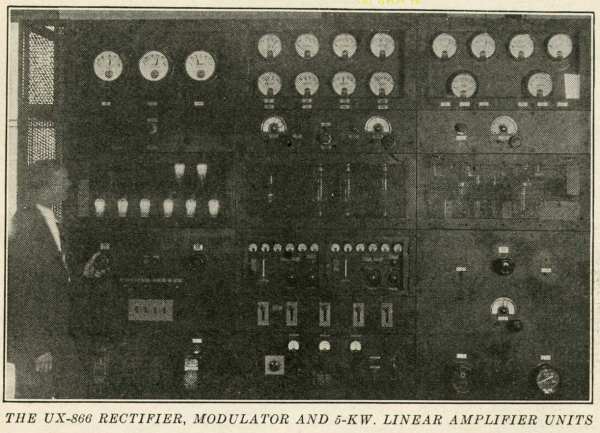|
AND MODULATOR ___The output of the second screen-grid amplifier is capacitively coupled to the control-grid of the UX-860, 75-watt screen-grid buffer-amplifier which is mounted in the compartment above the crystal-oscillator-amplifier units. Excitation is sufficient to cause this tube to draw 250 watts from the plate supply at a plate voltage of 3000. It is nearly biased to cut-off, bias voltage being |
realization of 100% modulation, and has been described previously in QST. The Class-C
amplifier is neutralized to prevent self-excited oscillation. Its plate tank is similar to that of
the buffer-amplifier; a copper-strip inductance tuned by a Cardwell transmitting condenser. |

|
obtained from the station grid-bias generator. Screen-grid voltage of 750 volts is obtained from the
plate supply through a suitable resistor. The plate supply for the buffer-amplifier, as well as for
the UV-849 modulators and modulated amplifier, is obtained from the three-phase series rectifier
using six UX-866 tubes mounted on the left end panel. The plate tank inductance is of copper ribbon
wound on a hard-wood strip form and is tuned by a 7200-volt Cardwell transmitting condenser. |
load resistance of the modulator is the plate resistance of the modulated amplifier and the
conditions for maximum output are satisfied when the load resistance is twice the plate resistance.
The plate resistance of the two modulator tubes in parallel is practically half the plate resistance
of the single amplifier. Maximum modulator output, therefore, should be obtainable. Moreover, the
use of two tubes in the modulator makes possible complete modulation of the Class-C amplifier output
without overloading the modulator tubes. The plate input to each modulator tube is 100 milliamperes
at 3000 volts, a total input of 500 watts. Their grids are biased so that they operate on the linear
portion of their characteristic. Sufficient grid-swing is possible to vary the modulated amplifier
plate potential between zero and twice the operating voltage without noticeable distortion.
Non-inductive resistors are connected in the modulator grid leads to prevent oscillation at
ultra-high radio frequencies. Negative grid bias voltage is obtained from the bias generator. |